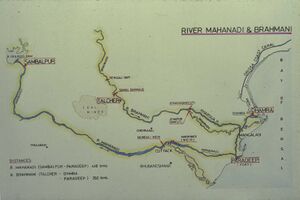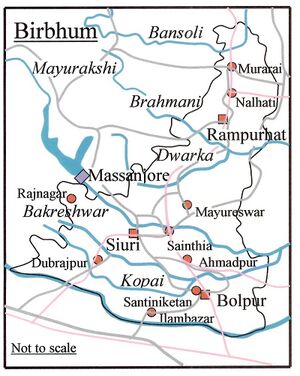Brahmani
| Author:Laxman Burdak, IFS (R) |


Brahmani River (ब्राह्मणी नदी) is mentioned by Mahabharata in Bharatavarsha. Brahmani is a major seasonal river in the Odisha state of Eastern India.
Origin
Variants
- Brahmani River ब्राह्मणी नदी (AS, p.652)
History
The Brahmani is formed by the confluence of the Sankh and South Koel rivers, and flows through the districts of Sundargarh, Deogarh, Angul, Dhenkanal, Cuttack, Jajapur and Kendrapara.[1] Together with the river Baitarani, it forms a large delta before emptying into the Bay of Bengal at Dhamra.
Sources
The Brahmani is formed by the confluence of the rivers South Koel and Sankh near the major industrial town of Rourkela at 22 15'N and 84 47' E. The Sankh has its origins near the Jharkhand-Chhattisgarh border, not far from the Netarhat Plateau. The South Koel too arises in Jharkhand, near Lohardaga, on the other side of a watershed that also gives rise to the Damodar River. Both of these sources are in the Chota Nagpur Plateau.
The site of the Brahmani's origin is mythologically reputed to be the place where Sage Parashara fell in love with the fisherman's daughter, Satyavati who later gave birth to Ved Vyasa, the compiler of the Mahabharata. The place is thus called Ved Vyasa.[2]
After assuming the name of Brahmani, the river crosses the Tamra and Jharbera forests, skirting along National Highway 23. It then passes the town of Bonaigarh in Sundargarh district before being dammed at Rengali in Anugul district. A large reservoir of the same name is created as a consequence. It then flows through the towns of Talcher and Dhenkanal before splitting up into two streams. The main stream flows by the town of Jajpur Road beyond which it is crossed by National Highway 16 and the Kolkata-Chennai mainline of East Coast Railway.
The branch stream called Kimiria receives the waters of the Birupa (a distributary of the Mahanadi, Kelua and Genguti before re joining the main stream at Indupur. It then flows crisscrossing through Pattamundai. The river then receives the Kharsuan, on its left bank before merging with the Baitarani, a major river, to form the Dhamra estuary. A distributary called Maipara branches off here to join the Bay of Bengal a short distance away while the main stream proceeds northward for a few km more before ultimately meeting the sea near Chandbali at Palmyras Point.
The Brahmani delta is the site of the Bhitarkanika wildlife sanctuary, famous for its estuarine crocodiles.[3]
In Mahabharata
Brahmani (ब्रह्माणी) (R) (VI.10.32)
Bhisma Parva, Mahabharata/Book VI Chapter 10 describes geography and provinces of Bharatavarsha. Brahmani River (ब्रह्माणी) is mentioned in Mahabharata (VI.10.32).[4].... and (Brahmani) Mahagauri, and Durga, O Bharata; and Chitropala, Chitraratha, and Majjul, and Vahini; (VI.10.32)
ब्राह्मणी नदी
विजयेन्द्र कुमार माथुर[5] ने लेख किया है ...ब्राह्मणी नदी (AS, p.652): उड़ीसा की एक पवित्र मानी जाने वाली नदी जो जिला बालासोर में बहती है. उसका महाभारत भीष्मपर्व 9,33 में उल्लेख है-- 'ब्रह्माणीं च महागौरीं दुर्गाम अपि च भारत'.
ब्राह्मणी नदी परिचय
ब्राह्मणी नदी का उदगम दुमका ज़िले के उत्तर में स्थित दुधवा पहाड़ी से होता है। यह दामिनी-ए-कोह में झिलीमिली और मोसनिया बंग्ला होते हुए बहती है। यह दरिन मौलेश्वर के पास दुमका ज़िले को छोड़कर झारखण्ड से बाहर निकलती हुई नलहाती रेलवे स्टेशन के पास गंगा में मिल जाती है। ब्राह्मणी नदी की प्रमुख सहायक नदियों में गुमरो और एरो हैं। [6]
External links
References
- ↑ http://www.india9.com/i9show/-Orissa/Brahmani-River-20953.htm
- ↑ http://dsal.uchicago.edu/reference/gazetteer/pager.html?objectid=DS405.1.I34_V09_016.gif
- ↑ http://wikimapia.org/#lat=20.5569383&lon=86.7305374&z=11&l=0&m=a&v=2
- ↑ ब्रह्माणीं च महागौरीं दुर्गाम अपि च भारत, चित्रॊपलां चित्रबर्हां मज्जुं मकरवाहिनीम (VI.10.32)
- ↑ Aitihasik Sthanavali by Vijayendra Kumar Mathur, p.652
- ↑ भारतकोश-ब्राह्मणी नदी]

